1) HifiMan isn’t really a bang-for-the-buck brand of DAP, and shouldn’t be considered in that way. It is targeting at a higher end market of portable user where price is much less important than performance. It is for those who demand the best of portable sound at almost any cost (as for whether they are indeed the best sounding portable players or not is a discussion for later on).
2) HifiMan isn’t meant to be sleek or trendy. If you want something that does video, touch screen, games, slim, light, very easy to use or seamlessly compatible to most music downloading service – then sorry, this is not that player. You should try Sony, Cowon, Apple, Sandisk or even Creative instead. HifiMan is a brand that orientated around sound quality, and it will require a bit of knowhow and effort from the user to get the best out of the player.
If you don’t consider yourself to fit into both descriptions, then perhaps HifiMan isn’t the right DAP for you, as attractive as many rave reviews you might have read. It is not because these reviews are not correct or the reviewers are some kind of elitist or obscure audiophiles. It is because where you might be looking for a DAP in general usage, they (and perhaps me in this case) are looking for an best, uncompromised sounding portable source that will better fulfill into their quest of sound quality.

SPEC

(9V battery as size reference)
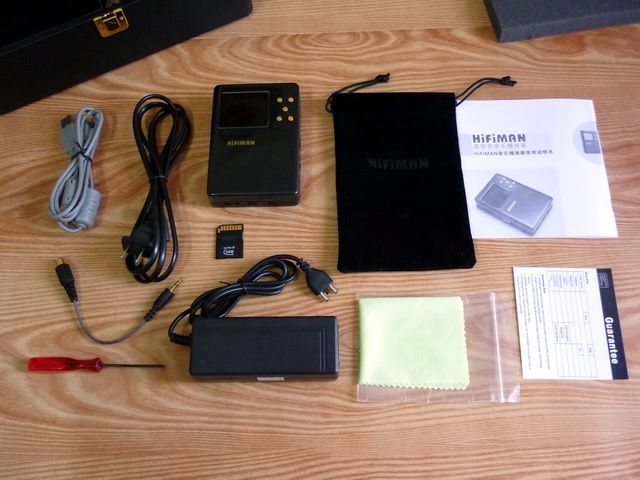
(SD card as size reference)
HM-801
Modular Design: Modular amplifier bay (‘GanQi‘ Bay) and removable Li-Po battery
Memory: 2GB onboard, SDHC slot
Frequency Response: 20-20K Hz
DAC function: Coaxial-in, USB DAC.
DAC Chip: Burr-Brown PCM1704; I/V Op-Amp: OPA627
Standard Amp Module: OPA2107
Weight: about 260g
Size: 114 mm *78mm * 25.5 mm or 4.49 * 3.07 * 1.00 Inch
Output: Headphone out; Line out
Battery Life: 7 to 8 hours (Amp module dependent)
Power supply: External PSU acts both as charger and external power supply that delivers more power for SQ improvement
Accessory: Li-Po battery; Charger/External Power Supply (110-240VAC, 50-60 Hz); USB cable; RCA-to-Mini adapter for digital coaxial input; screw driver for amp module installation.
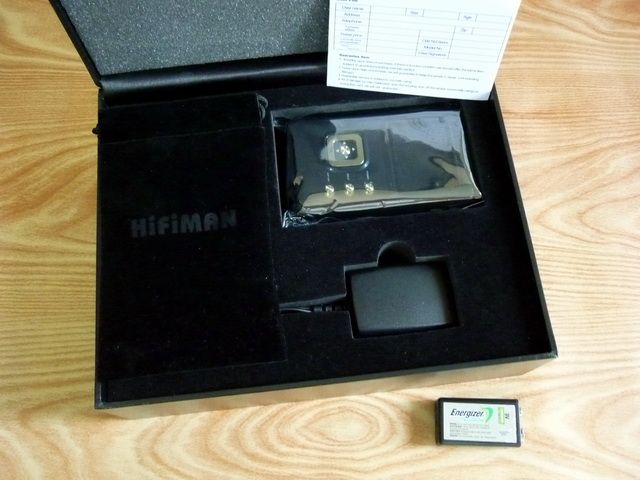
(9V battery as size reference)
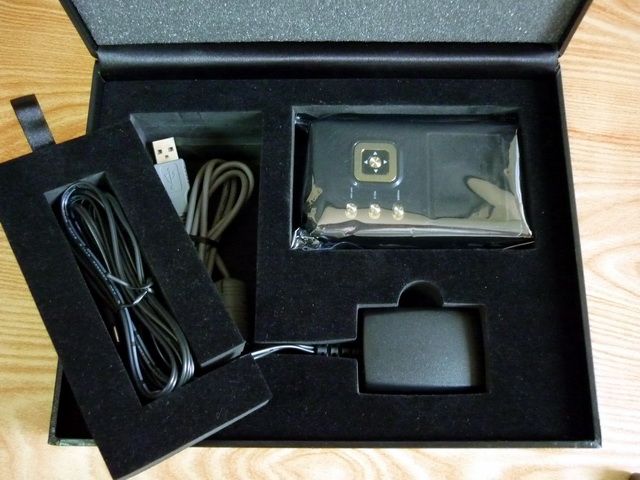
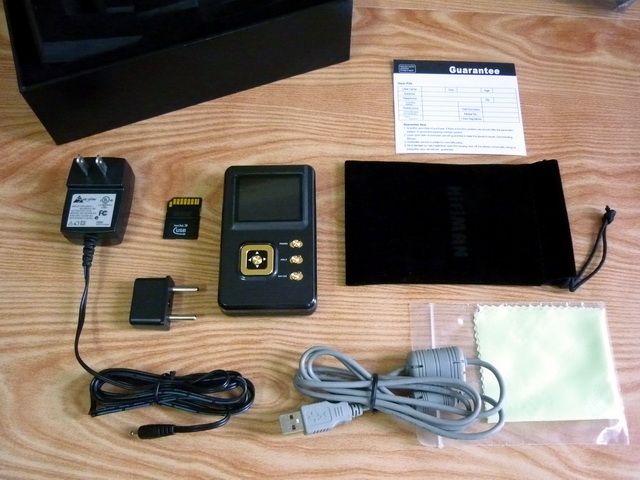
(SD card as size reference)
HM-602
DAC Chip: Philips TDA1543 in Non-Oversampling (NOS) configuration
LPF Op-amp: OP275, OPA2604
Headphone Amplifier Op-amp: OPA2107
Frequency Response: 20-20K Hz
Distortion: 0.09%
S/N Ratio: 92 dB
Stereo crosstalk: 74 dB (Lineout)
Headphone Amplifier Output level: 1.1v at 32 Ohm; 2.2v at 150 Ohm
Max Output: 30mw at 32 Ohm; 26mw at 150 Ohm
Size: 62mm*103mm*26.5mm or 2.4 * 4.05 * 1.04 Inch
Weight: About 200g
Memory: 16GB (onboard) + SDHC slot
Battery Life: 9 to 10 Hrs
I / O: Headphone Output; Line Output; USB Data Exchange; USB DAC Input
Selectable High / Low Gain
30 days refund, 90 days free replacement and 1 year repair warranty for both models.
Sidetracked
*No need to read this section if you are not interested in some personal mumbo jumbo.
What began by Red Wine Audio’s iMod (iPod modified for better SQ) a few years ago started a trend in a small group of DAP users to look for the possibility of bringing desktop level sound quality into the digital portable world. HifiMan is the first to answer that possibility and probably going to mark a new niche DAP market dedicates toward the audiophiles community. It shouldn’t be surprised to see such diversification in the DAP world where the market as a whole is booming yet increasingly begin to show sign of monopoly. The vivacity and creativeness from numerous relatively small DAP manufacturers in the beginning of this century has slowly been replaced by a small handful of big cooperates’ marketing machines. As a user, you get more and better features but lose the number of choices. If you are the minority who value a certain trait over all others, it is either settling down with the crowd pleasing products or be left alone with your out-dated piece of gear. Don’t get me wrong and think I am some kind of hater, which I am not. It is how most markets evolve and grow and I have no problem with it. It is just more of less a rant from an old timer who has experienced the taste of a different era (*I have been using DAP since 1999). But like any market that begins to reach its maturity, the minority often also grows enough to have a voice of its own – at least in this case, the audiophiles do.
After HifiMan released, it has been met with a lot of doubts and criticisms. Some of the more noticeable one is the treble roll off (attenuation) between 10 kHz to 20 kHz. It is about -2.5dB on 15 kHz and roll down to about -5dB at 20 kHz. While some consider it as a defect in design, it is actually being done intentionally. There is always a low pass filter after the DAC stage (or integrated internally) to remove the high frequency component (> 20 kHz) in order to remove noise as well as the inaudible frequency. Human hearing is generally recognized as 20 Hz to 20 kHz, but in real life the full range is between 16 kHz for most adult and down to 80 Hz in bass (*anything below increasingly tends to be felt more by skin rather than heard by ears, which we often refer as ‘chest pounding sound’). What HifiMan employed is called a Butterwoth filter (a.k.a. Maximally Flat filter). AS I have read, the characteristic of this filter is that the passband (the desired range) has a maximally flat response (no ripple in frequency response) as well as a more linear phase response (no uneven phase shift in individual frequency). The downside is that it doesn't roll-off quite as fast as other types of filters (which create the slope or ‘roll off’ in HifiMan’s upper treble). I think the consensus is that there is no such thing as one perfect filter for everything. Each type of filters has its own pros and cons and it is up to the implementation as well as what goal the designer wants to achieve to determine what is best for a certain design. In fact, quite a few well regarded high-end DAC and CD player also employs Butterwoth filter because it is considered more analog, musical sounding than other filters. I think the problem of Butterwoth filter on HifiMan has less to do with actual performance, but whether some can accept that you don’t need absolute perfect flat line to create a player that sounds good. If you can’t, then you know what you won’t be buying. I am not an electronic or audio engineer that can tell you what should have been done that could yield a better result or whether a Butterwoth filter is indeed the right choice – but rather trying to interpret whether the end result sounds good to me or not
Add on to the issue of filter, there is also measurement done on HifiMan to show that they don’t measure-up to many of the popular brands of DAP in the market. This reminds me an old saying: “If it measures good and sounds bad, -- it is bad. If it sounds good and measures bad, -- you've measured the wrong thing.” (*quoted from Daniel R. von Recklinghausen) No one will argue that a vinyl LP will measure badly when compared to a CD, or a tube amp will introduce noise to a bit-perfect signal. If such are the cases, why oh why anyone want to listen to LP and use tube amp? If we were to look at the other side of the story and assume there is some way of reproducing music perfectly - won’t we be listening to the exact same sound from whatever source, amp, and headphone we use? I have listened to some very well regarded headphones in my life, yet none of them sounds identical or could everyone agree that one of them is undoubtedly the ‘correct’ sound. Perhaps the real reason is, we are not listening to just plain sound reproduction, but music – sound that tries to convey a certain emotional attributes from the musician to the listener while also being affixed with some kind of unique emotional value by individual listener. On that understanding, I would personally like to believe that whatever gears we choose to ‘feel’ the music becomes part of the emotional value we add to the listening experience. From the source to the headphone, they are the instruments that translate the music for us and help us to interpret the music in each of our own ways. That is, sound isn’t just being transformed to music by modern tools with subjective measurement based on bit-prefect’s theory, but also how it is transformed and whether the transformation allows us to better enjoy the music (*which in some way related to how we interpret synergy between gears). That is, if you can enjoy the sound of LP or tube amp, then perhaps it is not too obscure to think that measurement is not the only factor on determining sound quality on a piece of gear. In the end, it is in my opinion that the music experience should go beyond simple sound reproduction or pure artistic expression but transcend both science and art in reach of a balance. As for how to define the ‘balance’, it should be up to the individual listener.
Understandably there are those who believe gears should be as faithful to the original recording as possible or at least trying to be ‘technically ideal’. I can’t say such school of thought isn’t correct in its own perspective. However, it should be noted that whether you find your own balance on one side or the other (or in the middle), you are still only your own judge. There is no need for anyone to prove to the world that (s)he has a better way of listening music, but merely what could contribute to a more fruitful experience on individual level. The real important bit for a reader and potential buyer is to be informed about the choices you have and able to make the decision without totally based on hearsay or denying all but one possibility because someone has said so. If you can’t be sure, just gives yourself more time and take the chance to audition gears from friends, in meets or retail stores before making up decision. No matter how much you read, nothing in the world can replace real experience. You can still make mistakes, but it is part of the process in learning and discovering your way around the audio world.
Build Quality and Accessories
Build quality is pretty good with both models, but not in 100% perfect condition. You can still tell that there are some screws that don’t align 100% flatly and the reset hole is a bit too small even for regular paper clip. But these are mainly minor cosmetic issues and I am just nitpicking because of the price tag over these players. Overall they still look and feel very classy and well made. In comparison, HM602 looks obviously better in buttons design and arrangement than HM801. I guess you can say the design team does learn from their experience on HM801 as the original ‘X’ arrangement of the buttons is a bit awkward and takes time to get used to. The paint job on the housing is quite excellent and really showcases the golden buttons well (which are actually gold plated). Both players have a small screen but have good visibility even under the sun.

Screen and X arranged navigation buttons on top. On the side: (from the right) volume control, line-out, Coaxial/ USB input selection, DAC/Player Selection, Coaxial-in.
On the buttom, power in, USB DAC in, USB DATA in, Reset.
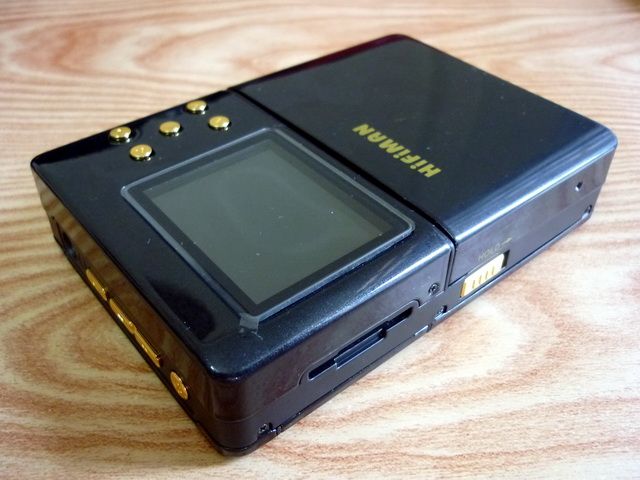
On the left side: power on/off, play/pause, next/previous. On the right side: SDHS slot, Hold key.
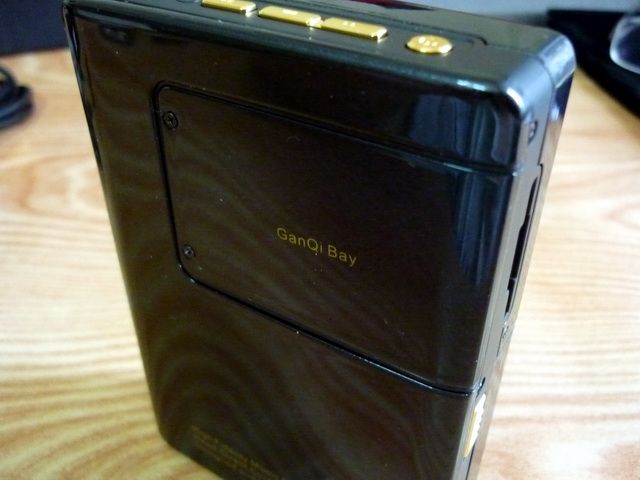
Mudular amp bay

Battery compartment and the Li-Po battery
Accessories wise, HM801 comes with one power cord, one fairly light switch mode AC adapter (older batch used to come with big and heavy linear adapter), a good quality USB cable, a coaxial-in cable, a small screw driver for opening up the amp module cover, a velvet soft pouch, a piece of micro fabric cleaning cloth, a simple manual and the warranty card. HM602 comes with a small AC adapter, the same type of USB cable, a velvet soft pouch, a piece of micro fabric cleaning cloth, and the warranty card. Both players are shipped in rather big, great looking boxes, so it is almost guarantee that the custom official will take notice on the package and tax you on it.
Portability wise, neither players are what considered small these days. But as a cassette and portable CD player user from the early 90s, I don’t see either as outrageously large or heavy. Even HM801 is really no bigger than most early generation of iMod + LOD + amp configurations back in 2006/07. I guess people these days are pretty spoiled by the ultra portable options we have now though I don’t think any of you who want a HifiMan will really care about size and weight that much.
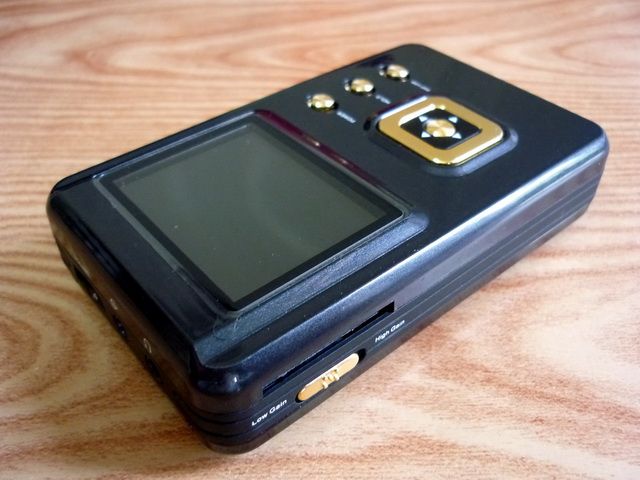
On top: Screen, Navigation keys, Power, Hold, DAC switch. On the right side, SDHC slot, Gain switch. On the Left side: Volume Control, Line-out, Headphone-out

On the bottom: Reset. On the right side: USB DATA in, USB DAC in, 5V input.
Overall, I am quite happy with the build quality of both players. Just a few suggestion though: a dummy SD card to fill the empty SD slot (I can imagine some might not use the SD card slot on HM602 due to the 16GB on board memory or when the players are mainly used for DAC function). The placement of USB port and power socket on HM602 will make more sense if they are closer or at the bottom. Last but not least, a custom made leather case, even as an extra purchase.
On a side note, there have been some hardware reversions on both players. There are two type of standard amp module for the HM801 (early batch on OP275 and current batch on OPA2107). Plus another updated version (the ‘power’ amp module) will be released soon as the default standard amp module. There is also the GAME card as a separate purchase and it is designed for earphone. There will probably be a balanced output module in near future as well. Also, the latest batch of HM801 will have an 8GB onboard memory due to shortage of 2GB chip in China as announced by HifiMan. On the early HM602, there is some issue with certain transistor and output caps that limits the bass performance, but these issues only limited to very early pre-release testing batch and demo units. These problems have been fixed upon official release
Navigation and Format Support
User interface (UI) and navigation are both fairly primitive on both players. Basically you get a first generation iPod like interface and move around with left/right (in/out sub-menu, right also serves as select or extra function sometime), up/down (up/down in menu, forward/reverse in music playing) and a center button (select, play/pause). In some rare occasion, I notice both players will mistake up/down to be left/right. It doesn’t happen often nor does it really affect navigation in most part though I reckon it is something to look into in future firmware update (as it doesn’t seem to be a hardware related issue).
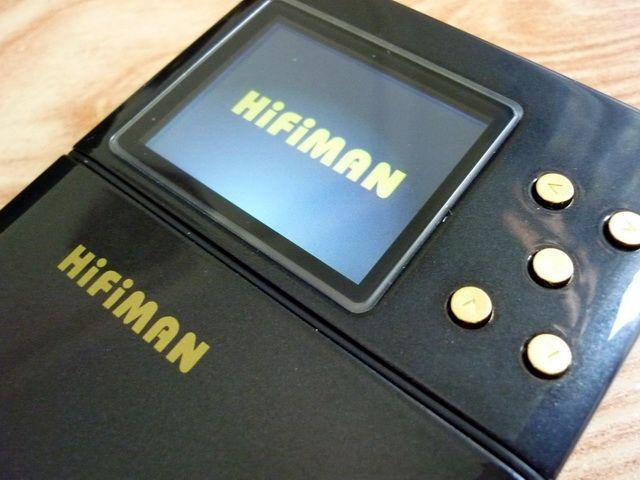
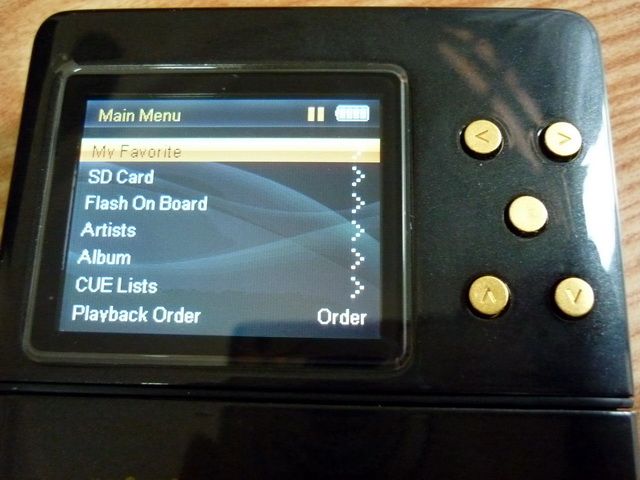
Though primitive, navigating around is still relatively smooth and easy, just not particularly fast. The best part about the UI is that it allows the user to turn off or hide any sub-menu / features that is not in use, i.e. you can hide the ‘on board flash memory’ in the setting and it will not be displayed on the main menu, and thus making the main menu less cluster.
Volume control is done via potentiometer on both DAP and the good part is they don’t get unbalanced in low *listening volume (only tested on my own IEM for low listening volume. Other IEM, especially low impedance high sensitivity one might still face such issue in low volume). HM801 also comes with an extra set of buttons (play/pause, next/previous) on the top, next to the headphone-out socket. The idea is to make music playing a bit easier when the player is in the pocket. Both players have a little 'pop' sound when turning on, so be careful when you already have headphone plugged when fillping the switch..
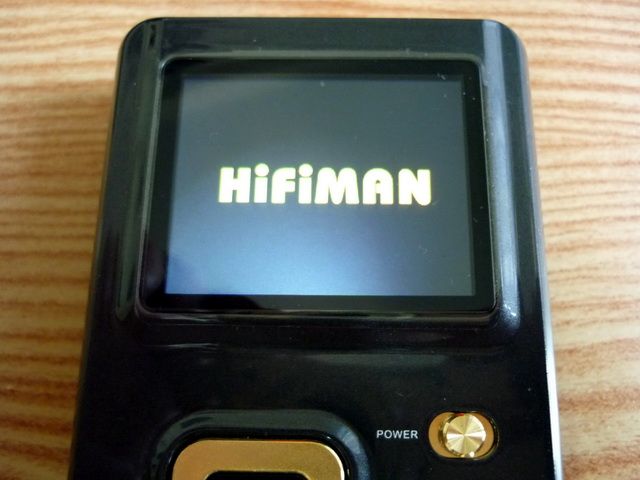

The officially supported formats for both players are as follow:
APE: Fast、Normal、High Mode
AAC: 16K-320Kbps
FLAC: 16bit 44.1 kHz and 24bit 96 KHz
WMA: 8-355kbps
OGG: Quality 0- 10
WAV: PCM, MS-ADPCM, IMA-ADPCM
MP3: (VBR+CBR) 8-320Kbps
The formats I did try (and work) are APE Normal, AAC 320kbps, FLAC 16bit 44.1 kHz, WMA VBR Q98 44.1 kHz. WAV PCM and MP3 CBR 320kbps. A few things to note: 1) for all the formats I play around, HifiMan seems to support FLAC, MP3 and WMA the best. AAC is the worst as only .acc is supported yet still feel fairly buggy in playback. 2) ID3tag is not that well supported, especially for formats beside MP3 and WMA. My personal suggestion is to keep all your music ID3tag as simple as possible and without any album art (not that HifiMan support album art anyway). I guess between FLAC and mp3, most people should be covered. For those who rely on iTune, hopefully all your music collection is lossless and DRM-free, which means transcoding to FLAC or MP3 CBR 320kbps won’t be a problem for you. If not, that will be something to think about before you decide whether it will worth the effort to rebuild some of your music library.
This is where I think HifiMan firmware team should spend more of their time on – not to get more / new features to the players but rather getting the current firmware more refined. Between the two players, I had only crashed HM602 twice on the first few days during months of usage because I was trying to force my PC to play nice with it. It turns out that my aging PC isn’t really want to do the whole ‘safely remove’ thingy but rather prefers straight unplug as much as possible. The same situation also happens to my USB drive so it is not the fault of the DAP.
Gapless playback is not supported simply due to hardware limitation (so don’t expect firmware update to fix it). It was said that a workaround is to rip the entire album into one file (presumably FLAC) than use cue sheet for music playback. I don’t have any music with me that really needs gapless playback so I didn’t bother to try this one out (*as mentioned by others, this probably won't work. It will still plays the music as single file, but without ability to skip song). Also, my music collection is mainly based on the good old 16bit 44.1 kHz CD rip to PC, so none of all digital music is 24bit. Therefore 24bit music is not tested as well. In any case, I don’t find the 24bit music download service to be mainstream enough to affect my current music preference. I’ll rather have more better mastered 16 bit music for now.
Battery Life
The listed battery life is about correct for both players as I can get around the same useable time. It really isn’t much of a battery life for either player as most DAP these days can last several times longer. However, given the serious amount of hardware used in both DAP and the capability of their output, it is understandably why the battery life is relatively short. It is also noticeable that both players will heat up just a few degrees in use, but not enough to be a real concern but just so you know in case you even plan on getting either one of them.
I can confirm that external power pack with mini USB 5V output can plug into the HM602 during use to recharge the battery on the go. On the HM801 however, the only real option on extra battery life seems to limit to carrying an extra Li-Po battery or the AC adapter. The current switching power supply is pretty nice, small enough (roughly same size as notebook adapter) for traveling and much lighter than the old, extremely heavy linear power supply. Both stock adapters will charge and supply more juice to the players when they are used as desktop/USB DAC.
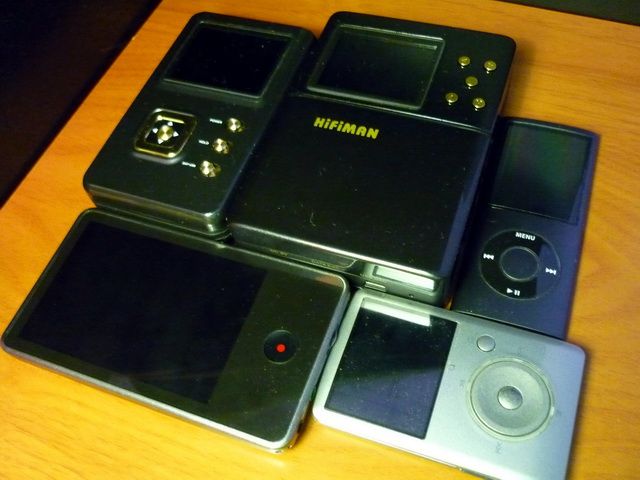
Size comparison: (top from left) HM602, HM801, Nano 4G. (bottom from left) S:flo2, Sansa Fuze.
Sound Quality
[…as Portable Player]
HM602 is a bit on the warm side, definitely with some coloration on the mid. The overall sound signature reminds me of my old trusty Sansa Fuze. Though not identical sounding, they both share a kind of warmer tone in the music that tends to be more laid back, musical, and relaxing for the listener. I would describe it as having a certain analog quality in the sound, something that reminisces my old Technic portable CD player that I find more musical and joyful to listen compared to all the Sony variants I had later on (that is when Technic was still part of the original Panasonic parent company that responsible for developing higher end PCDP). In actual comparison, HM602’s mid is just a bit more forward and makes the vocal slightly sweeter than Fuze. At the same time, HM602 also has a more expensive soundstage, overall depth, air and imagine where Fuze tends to feel a little cluster in comparison. Treble is a little roll off – by ‘a little’, I mean I can only detect up to 16 kHz before noticeable decrease in signal strength (in frequency sweep) instead of the usual 17 kHz using HifiMan RE0 (which has the best extension in all my IEM). If your headphone (or hearing) doesn’t extend quite as far as RE0, I doubt you will notice much difference. In real listening, HM602 treble does tend to be hiding a little behind the mid – while treble roll off might be one of the reason, I think the more forward mid plays a bigger role here on overshadowing the treble and gives it a warmer tone. Bass is punchy with good body while well controlled, thanks to the relatively high output of the amp section (which I believe is similar to that of HM801). The player drives relatively high impedance IEM with ease – ER4S, RE262 and RE0 all performs well, but synergy wise I think analytical and leaner sounding IEM really pair well with the warmer sound of HM602. One of the IEM that is not quite suitable with HM602 is the very warm and smooth sounding Westone UM2, which I think can be too dark for most liking. While doing the frequency sweep on treble I notice the HM602 has a certain strange but very faint background hiss. It doesn’t really affect normal music playback but I think it is a distinct characteristic of the NOS DAC as I didn’t detect the same hiss on HM801 or any other DAP and DAC I have.
One DAP that contrasts the HM602 well is the Nationite S:flo2 (a.k.a. Teclast T51). If HM602 is what considered to be a good musical, analog sounding DAP, then S:flo2 will be no doubt be the digital sounding DAP – it is more transparent (colorless and flat), cleaner and colder, and without obvious emphasis on any part of the frequency response. It is also more or a ‘wow’ type of player that will impress people at first listen rather than the more relaxing, laid back HM602 which tends to grow on the listener in time – Thus is the impression I have on s:flo2: technically excellent but lacks a loveable personality. As for a direct comparison with HM602, I think the difference in sound signature really outweighs the difference in technical ability. They both sound good enough for what they do, but if you already have and love one of them, then I don’t see a lot of reason to opt for the other. If you are trying to decide which player to get, then there are other factors to consider beyond the different in presentation: They are roughly the same weight (HM602 is only 30g heavier and you can’t really tell the difference in pocket) and don’t have the smallest size among DAP, s:flo2 has a big screen for video and picture while HM602 is purely a music player but can function as a USB DAC, neither has a perfect firmware, UI, extra long battery life or a really large onboard memory (enough for lossy but a bit small for lossless). My recommendation to you will be, just choose the player you see yourself using more. There is nothing wrong one way or the other.
---------------------------------
HM801 is on another level of its own, certain beyond what HM602 or s:flo2 can conjure in every possible way. As the original big daddy in the HifiMan line-up, it really makes me feel like it has spared no expense or cut any corner on bringing the best possible sound out of a DAP. Yes, it is heavy (and the battery takes 1/3 of the total weight!). But if you were to consider an iPod Classic with a decent size amp, they are almost just as heavy and probably even bulkier than HM801 – and I can imagine they are not going to be as good sounding as HM801 alone. So what really makes HM801 that good sounding as a DAP? I think the PCM1704 DAC chip really works its magic here. Consider it is so expensive (US$40+ for single chip and US$30+ in 100+ bulk order) that the price tag is enough to buy a decent sounding small DAP on its own, no other companies has ever thought of using it outside of a desktop machines. Yet somehow it is put together by HifiMan as the HM801 and starts to bring what regarded as the desktop sound quality into a portable setup – what a job they did!
So how would I sum up the sound of HM801? ‘Effortless’ is the word that pops into my mind – not just effortless as a DAP, but like a good desktop source in miniature. In many occasions, I was totally immersed into the sound of HM801 that I can’t quite get from any other DAP. It is not a sound that I would describe as either analog or digital, but rather a good balance between them – technically I can’t find any flaw in the sound, yet it still has a sense of musicality in the overall presentation that doesn’t feel forceful or lay back to the listener. Instead of being ‘wow’ by such a good sound, more often my ‘wow’ comes from switching from HM801 to a lesser source, where suddenly it is clear, ‘why doesn’t this sounds as good as HM801?’
If you are coming from HM602, you might assume the treble will be just a bit roll off on the top end because of the same Butterwoth filter, but for some reason I can still hear the 17 kHz on RE0 clearly on HM801 as I have from s:flo2 or Fuze (which is the reason why I believe the more noticeable roll off on HM602 has more to do with its warmer, mid focused sound rather than the filter itself). However the way the treble is presented does seems to be less aggressive when compared to s:flo2, just that I don’t feel like there is any problem with it. If anything, I really like it that way. Mid is quite neutral, and perhaps felt just a tiny tad warm and euphonic to the ears. Bass is adequately strong and well controlled. One thing that really stands out is the exceptionally wide soundstage and instrument separation, as if there is almost no limitation on how far it can reach out and how well you can tell the position of one instrument or singer to another. Almost every IEM, earbuds, on full size that I listen on the HM801 turns out to be better sounding than on any other DAP I have.
Given that the amp section is similar between HM602 and HM801, the performance is really good. At least I can’t tell much difference in performance when comparing the amp section to Meier Audio Corda 3MOVE (via the players’ line-out). On the other hand, almost all headphones sound fuller with StepDance because of its active balanced ground, though improvement is not obvious for the easy-to-drive IEM that I have. I think the same conclusion can be drew for most full sized cans as well, that the standard amp module is quite a performer and the benefit of carrying an extra portable amp is pretty small, even for most top-of-the-line portable amp. However, as noted before that a new standard amp module will be replaced by the new ‘power’ amp module soon and there is the release of balanced output amp module on 2011, so there will be some change on sound in the near future for HM801
[…As Desktop DAC]
Looking on both HifiMan, I think it is hard not to notice their designs are both oriented around the DAC before everything else. HM602 has the NOS DAC design that is quite popular among the DIY community while HM801 has the PCM1704 which is well regarded on high end DAC. Both players can be used either as USB DAC + AMP configuration or standalone USB DAC by feeding the line-out to another amp. However, HM801 also has the capability to accept coaxial-in with the included adapter cable so it can support 24bit music which is not supported by the USB receiver chip.
My rig is almost built entirely for portable use, so I don’t really have really good desktop gears to test both players fully as desktop solution. However, here are a few things I did:
At first, both players are tested as USB DAC + AMP and pure USB DAC (feeding 3MOVE via line-out). HM601 carries the same warm sound as it does as music player. It sounds better than 3MOVE in same configuration, which is a sign that the 3MOVE internal USB DAC can’t quite keep up with the NOS DAC. Feeding HM602’s line-out to 3MOVE really shows the difference between the two DAC, but as mentioned, HM602 amp and 3MOVE perform quite similarly. Contrarily, HM801 doesn’t sound quite as nice when it is used as either USB DAC + AMP or as pure USB DAC. While still better than HM602 in general, it sounds warmer and not quite as effortless. It seems to lose a little resolution as USB DAC. When comparing both players to NuForce uDAC’s line-out, it is clear that uDAC has a colder, cleaner and more digital-like sound, but I won’t say it is superior in anyway (kind of like the comparison between s:flo2 and HM602 in previous discussion). On the other hand, uDAC headphone-out is clearly not quite as good as HM602 or HM801 on USB DAC + AMP mode.
With the surprise of HM801 relatively limited performance as USB DAC, I retested HM801 DAC function with coaxial-in by feeding it the NuForce uDAC coaxial-out. The effortless sound returns immediately, allowing the HM801 to really sing on its full glory and showcase its superior DAC over that of HM602 and uDAC. I come to the conclusion that that it is likely the USB receiver chip or its implementation that is the bottleneck on HM801 DAC design, and you will be better off with the coaxial in rather than the USB input.
Sum of All Fear
Here is just the summarization of what I think can be improved on current as well as future HifiMan: 1) I like the size, weight and design of HM602 but the SQ of HM801, so it is not crazy that I want a DAP with pros of both and cons of none. 2) Firmware could need more work, and it should be on refinement rather than trying to add more features. 3) EQ really sucks. While it really don’t bother me much as it is not EQ I am looking for on a DAP, some might. It will be nice to have the choice as a user. 4) Gapless, which is in a similar situation as EQ and worth the consideration for future model. 5) I am in luck as both of my 16GB SDHC card work on both HifiMan, though there are reports that some won’t work, especially when the card is fake. 5) All the other bits and pieces on different paragraphs.
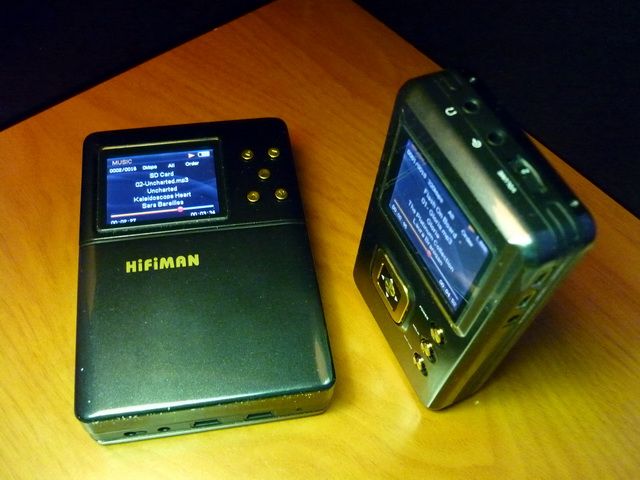
Verdict
Even since the release of the first HifiMan, we have seen quite a few other similar offerings (SQ oriented DAP) as well and I have had the chance to play with a few of them. At this point, I think I can still safely conclude that none are perfect when it comes to pure usability and features when compared to the mainstream DAP. On the other hand, there are those who believe that all the so called ‘audiophiles DAP’ are nothing more than hype or marketing scam aiming to rip people off with their ‘big’ audiophiles’ price tag and limited features. I will be more than happy to see if big brands decided to release DAP that are just as good sounding as HifiMan with great features and low price that mirrors their mainstream products. But until they do, daydreaming on what could or should have been done is a waste of time. Instead, let’s focus on what we have now. If you can’t have it all, then pick the one that suits you best. Note this though: It is not delusional to want to own a HifiMan, as they do have the sound quality to warrant the return for those who know what they are looking for. It will be delusional to want to own a HifiMan and expecting nothing but perfection because of the high asking price. Do you want big bang of the buck factor, sleek UI, touch screen, great EQ, perfect measurement or exceptionally long battery life? If you do, I am sure there are plenty of DAP that fits what you need. I’ll recommend HifiMan to you for one reason and one reason only: the oh-so-sweet sound I have heard from both players: HM801 is a great sounding DAP when SQ is the only concern, HM602 will be good if you want something warm and sweet. Now all you need to do is to figure out your priority.
------------------------------
Extra reading, if you have the time...
- Wiki article regarding Butterworth filter.
- The translated original NOS DAC paper by Ryohei Kusunoki.
- Interview of Mr. Kusunoki on TNT-Audio.
- A white paper (PDF) from Lavry Engineering that explains why they think oversampling is better.
- Both HifiMan have relatively high output impedance which could cause over attenuation on certain frequency range in multiple-BA IEM due to the IEM’s wonky impedance curve. I find most of my multi-BA IEM plays fine with both players. However if this is a concern for you, here is a trick to lower the effect of output impedance on the IEM - build a bypass adapter. You can find more about this on Meier Audio website here.





